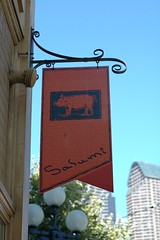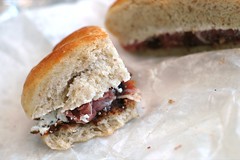
Jay Weinstein's The Ethical Gourmet is a sign of the times. Organic food is mainstream, sold from Wal-Mart to Whole Foods. Newspapers and magazines exalt humane meat producers and artisanal cheese makers. People want to do the right thing by their food, and they're learning that the right thing doesn't have room for industrial agriculture.
I imagine some, maybe many, readers will gasp at Weinstein's primer on the swamp of problems in our food system, though the natural audience may already know about the issues he covers. He includes crowded feedlots and environmental destruction but also child slavery and draining water supplies. Websites that give ethical options pepper the text, perhaps reason enough to buy the book. Simple breakdowns of government definitions decrypt the terms you'll see at the store.
But the text falters as it steps up to the teacher's podium. The book invites comparison with The Omnivore's Dilemma and Pollan's book makes Weinstein's look like the earnest essay of a college freshman. Pollan's book fills in every detail of our food chain, taking no knowledge for granted. Weinstein's book skates around large topics with hands behind his back—"This is not meant to be an exposé about the technique of veal manufacture, foie gras creation, or chicken farming. These stories are frequently reported in the news." But they're not reported. Or they're poorly reported. And he does nothing to change that. He parrots the standard "veal is bad" mantra, without asking if the industry has changed its practices in the face of consumer disgust. He pronounces foie gras "inhumane" with no supporting evidence. He glosses over modern pork facilities. And I wonder if Weinstein would be such a fervent supporter of industrial organic food after reading Pollan's book.
I'd also suggest he read George Pyle's Raising Less Corn, More Hell. He might sound less cavalier about the endangered small family farm. "The age of the industrial organic farm has arrived," he writes in the preface. "While bad news for some small organic farmers, it's a boon for the ethical gourmet." Later, he trumpets small farms but dismisses concerns about their long-term chances with a Pollyannaish there's-always-demand-for-quality-product attitude. There is reason to celebrate the change to large-scale production of pesticide-free food, but industrial organic farms are often monoculture enterprises with their own universe of subsidies, few of which reach the small farmers who practice true sustainable agriculture but struggle to survive. Small farms operate not in a free market but one in which the government funds their competition.
He breaks up the text with recipes—he trained at the CIA and has worked at restaurants and as a personal chef—and while many sound good enough, I am wary of any cookbook that suggests brining all pork, even when it's cut from tastier breeds. Brining replaces the flavor removed in the selection for industry-friendly breeds. Why bother paying for flavorful, juicy meat if you plan to overlay its taste with a coarser substitute? "The key to cooking meat that has great impact in small portions," he writes about brining, "is to make each morsel an intense flavor and texture experience." What about delighting with the subtle nuance and delicate taste of these breeds?
Finally, he seems to have had a slipshod editor. Read through the introduction and count the number of times the word "egregious" appears: It clangs like the clapper of an irregular bell. Another example from the preface, on subsidies: "Sugar is the most egregious [ed: of course] example, but wheat, soy, rice, and corn (the most heavily subsidized crop) also have hidden costs." Why is sugar the worst when corn is the most heavily subsidized? He leaves the reader hanging until some twenty pages later, when you get a sort-of answer about the destruction of the Florida Everglades. In one sentence he describes his first taste of free-range chicken thigh as banal; two sentences later he tells you how much flavor you'll find in a free-range thigh. Jarring examples leap out of each page, and someone at Broadway Books should have spotted them.
I believe everyone should know where their food comes from, and Weinstein and I agree on many things. But the book feels like it was rushed out by the publisher to meet a high point of consumer demand, and it suffers for it.







